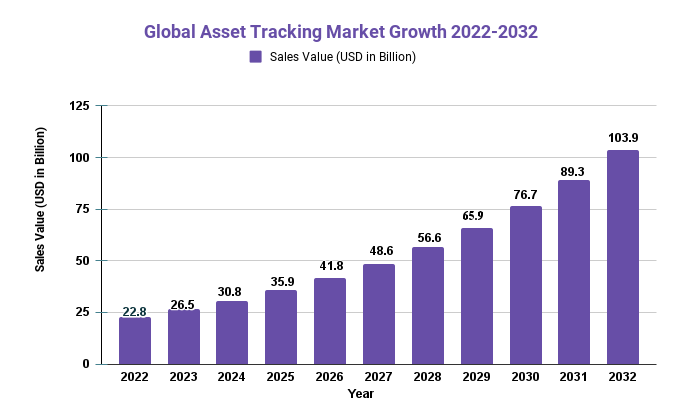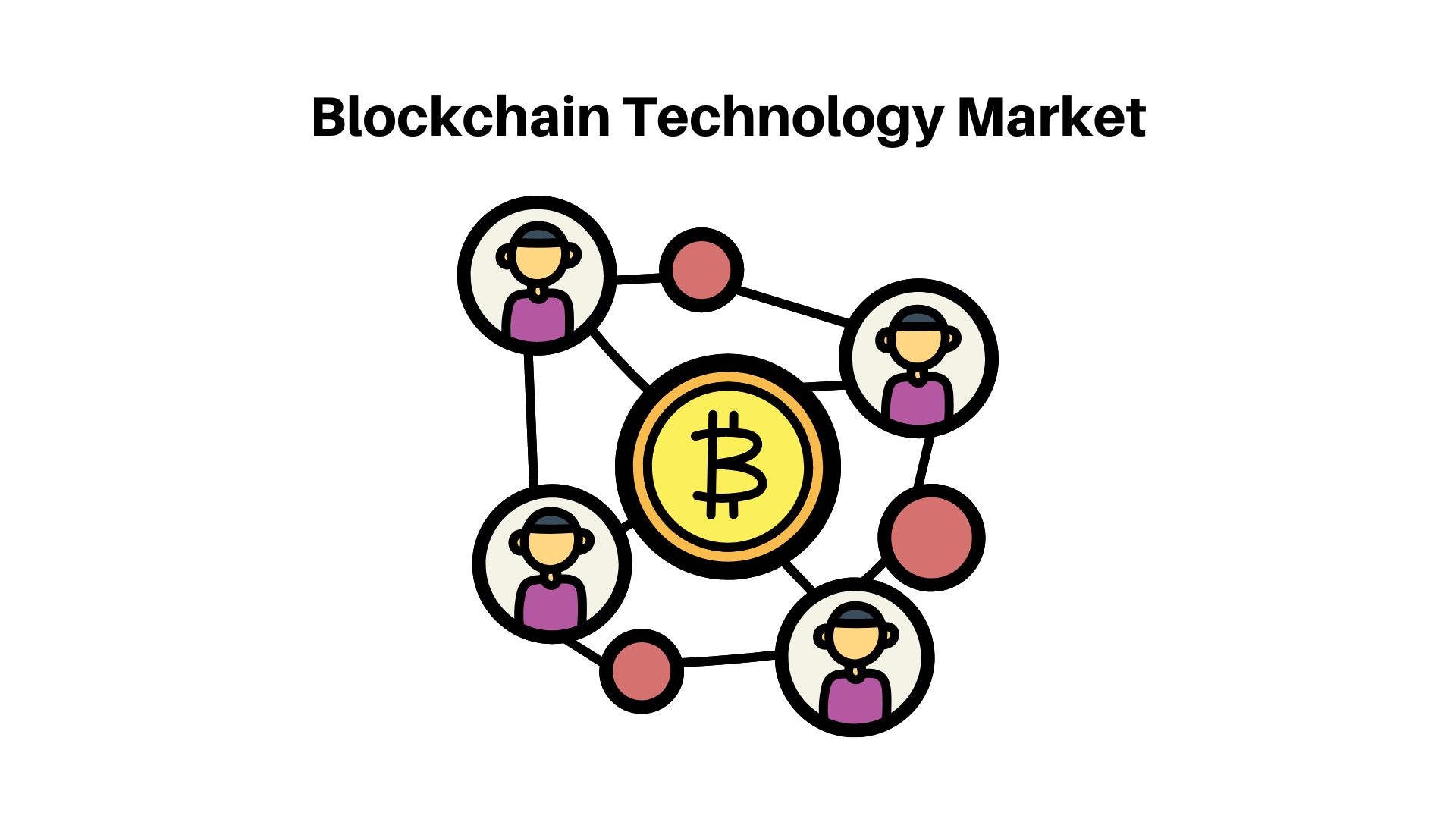Asset Tracking Market Size USD 103.9 Bn by 2032 | at a CAGR of 16.4%
Page Contents
Market Overview
Published Via 11Press: The Asset Tracking Market has seen rapid growth in recent years due to an increasing need for real-time tracking of assets across industries such as logistics and transportation, healthcare, and manufacturing.
Asset Tracking Market size is expected to surge from USD 22.8 billion in 2022 to an anticipated total of USD 103.9 billion by 2032, growing at a compound annual growth rate (CAGR) of 16.4% over this forecast period.
The asset tracking market is expected to witness tremendous growth due to factors such as rising demand for improved supply chain efficiency, better asset utilization and management, and the rising adoption of cloud-based asset-tracking solutions. Furthermore, the growing popularity of Internet of Things (IoT) technology and Industry 4.0 are expected to fuel this sector over the coming years.
Technology-wise, the asset tracking market can be divided into RFID, GPS, barcode, and others. Of these technologies, GPS is expected to hold the largest share in the forecast period due to its superior accuracy, real-time tracking capabilities, and diverse applications across various industries.
Geographically, North America is expected to dominate the asset tracking market during the forecast period due to a large number of key players in the region, rising adoption of IoT technology, and growing demand for asset tracking solutions across various industries.

Drivers, trends, and challenges have an impact on market dynamics, which can impact businesses. Request for PDF sample report
Key Takeaways
- The asset tracking market is expected to experience a compound annual growth rate (CAGR) of 16.4% during the forecast period, due to an increasing need for real-time asset monitoring across various industries.
- The GPS segment is anticipated to hold the largest market share during the forecast period, due to its superior accuracy and real-time tracking capabilities.
- North America is anticipated to dominate asset tracking during this time frame, followed by Europe and Asia Pacific.
Regional Snapshot
- North America: The asset-tracking market in North America is expected to be driven by the presence of key players, increasing adoption of IoT technology, and rising demand for asset-tracking solutions across industries such as logistics, healthcare, and manufacturing.
- Europe: The asset tracking market in Europe is expected to be driven by rising demand for improved supply chain visibility and asset management, as well as growing investments in IoT technology.
- Asia Pacific: The asset tracking market in Asia Pacific is expected to experience the highest compound annual growth rate during the forecast period, driven by increasing adoption of cloud-based asset tracking solutions, rising investments in IoT technology, and growing demand for improved supply chain visibility within the region.
Drivers
- There is a growing need for real-time asset tracking and improved supply chain visibility across various industries such as logistics, healthcare, and manufacturing.
- Furthermore, there has been an exponential rise in the adoption of IoT technology and Industry 4.0 initiatives.
- Asset utilization and management must be improved to reduce operational expenses, with some industries experiencing increasing government regulations that mandate asset tracking.
- Cloud-based asset-tracking solutions have become increasingly popular over time.
Restraints
- High implementation costs associated with asset tracking solutions.
- Lack of awareness and comprehension regarding the advantages of asset tracking in certain industries.
- Concerns regarding data security and privacy.
- Technical difficulties associated with the integration of asset-tracking solutions with existing systems.
- Limited battery life and connectivity range for certain asset tracking technologies, such as RFID.
Opportunities
- Advances in asset tracking and management using advanced technologies like machine learning and artificial intelligence (AI).
- Increased demand for asset tracking solutions across emerging markets such as Asia Pacific, Latin America, and the Middle East.
- Asset-tracking solutions have seen a resurgence in the healthcare sector, where they are used for tracking medical equipment and devices. Construction and mining industries also see an uptick in interest for such solutions to monitor heavy equipment and vehicles.
- The growth of the e-commerce sector necessitates improved supply chain visibility and asset tracking capabilities.
Challenges
- Integration issues with legacy systems and lack of standardization within the asset tracking industry.
- Technical difficulties related to implementation and maintenance of asset tracking solutions.
- Some asset tracking technologies, such as RFID, have limited battery life and connectivity range.
- Data security and privacy concerns arise when collecting and storing asset-tracking data.
- High implementation costs require specialized skills and expertise for successful completion; additionally, these technologies tend to have lower success rates overall.
Recent Developments
- In February 2021, Zebra Technologies launched its MotionWorks Proximity solution for real-time location tracking and contact tracing in the workplace.
- In October 2020, Honeywell launched its Connected Asset Tracking solution, which combines RFID and GPS technologies for real-time asset tracking and management.
- In July 2020, Microsoft and FedEx announced a partnership to develop a new platform for real-time package tracking and delivery management.
- In April 2020, IBM and Sigfox announced a partnership to develop a new IoT-based asset-tracking solution for the supply chain management.
- In February 2020, T-Mobile launched its Asset Tracking solution, which uses narrowband IoT (NB-IoT) technology for real-time asset tracking and management.
Key Market Segments
Type
- M2M/IoT
- Edge Computing
- Smart Devices
Application
- Aviation and Aerospace
- Commercial Vehicles and Fleet Tracking
- Local and State Government
- Manufacturing and Warehousing
- Personal Vehicles
- Public Transportation
- Shipping and Construction
- Healthcare and Medical
Key Market Players
- Actsoft
- ASAP Systems
- Asset Panda
- AT&T
- CalAmp
- Fleet Complete
- Gigatrack
- Microsoft
- OnAsset Intelligence
- Oracle
- Spireon
- Sprint
- Tenna
- Trimble
- Verizon
- Zebra Technologies
- SAP
- Epicor Software
- JDA Software
- Stanley Black & Decker
Report Scope
| Report Attribute | Details |
| The market size value in 2022 | USD 22.8 Bn |
| Revenue forecast by 2032 | USD 103.9 Bn |
| Growth Rate | CAGR Of 16.4% |
| Regions Covered | North America, Europe, Asia Pacific, Latin America, and Middle East & Africa, and Rest of the World |
| Historical Years | 2017-2022 |
| Base Year | 2022 |
| Estimated Year | 2023 |
| Short-Term Projection Year | 2028 |
| Long-Term Projected Year | 2032 |
Frequently Asked Questions
Q: What is asset tracking?
A: Asset tracking is the process of monitoring and managing physical assets, such as equipment, vehicles, and inventory, using various technologies such as GPS, RFID, and barcode scanning.
Q: What are the benefits of asset tracking?
A: Asset tracking provides several benefits, including improved supply chain visibility, better asset utilization and management, reduced operational costs, increased productivity, and enhanced customer service.
Q: What industries use asset-tracking solutions?
A: Asset tracking solutions are used in various industries, including logistics and transportation, healthcare, manufacturing, construction, mining, and retail.
Q: What technologies are used for asset tracking?
A: Technologies used for asset tracking include GPS, RFID, barcode scanning, and IoT sensors.
Q: What are the challenges associated with implementing asset-tracking solutions?
A: Challenges associated with implementing asset tracking solutions include integration challenges with legacy systems, technical challenges, data security and privacy concerns, limited battery life and connectivity range of certain technologies, and high implementation costs.
The team behind market.us, marketresearch.biz, market.biz and more. Our purpose is to keep our customers ahead of the game with regard to the markets. They may fluctuate up or down, but we will help you to stay ahead of the curve in these market fluctuations. Our consistent growth and ability to deliver in-depth analyses and market insight has engaged genuine market players. They have faith in us to offer the data and information they require to make balanced and decisive marketing decisions.



